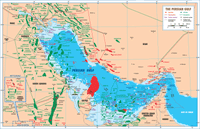|
Aug.
2001 Vol. 222 No. 8
International Outlook
|
MIDDLE EAST
Dr. A. F. Alhajji, Contributing Editor,
Boulder, Colorado
Qatar
It has been a good year in Qatar – higher oil
revenues and economic growth, more gas deals, development / expansion of all fields – and most
importantly, Qatar solved its border disputes with Saudi Arabia and Bahrain. In 2000, the country was second
(10 million t) to Algeria in LNG exports in the Middle East and North Africa.
In May, Qatar Gas signed two deals with Spain, to
supply 12.6 million t of LNG until 2012. In April, RasGas signed the world’s largest LNG sale / purchase
agreement with India’s Petronet Ltd. It calls for supplying 5 million t/year for 25 years. Earlier,
RasGas signed a deal to deliver 1.8 million t, annually, for 25 years to Taiwan, starting in 2003.
Qatar accepted the ruling of the International Court of
Justice on its maritime border dispute with Bahrain. Bahrain was awarded Hawar Island, while Qatar was awarded
the Zubarah coastal strip on the Qatari peninsula. The ruling led to plans by both countries to develop fields
in the area.
The Dolphin gas project started last March and began
pre-qualifying companies for five large contracts in May. The project will deliver up to 2 Bcfgd from Qatar’s
North field to Abu Dhabi and Dubai via a 217-mi (350-km) subsea pipeline. To reflect changes that are shaping
the nation, Qatar General Petroleum Corp. was renamed, "Qatar Petroleum," and given a new identity
and logo.
Exploration. Last March, Pennzoil and Novus
spudded an offshore exploration well in Block 8. The PQ-5 is in the NN-North prospect, near Najwat Najm field.
Late last year, Chevron relinquished offshore Block 1 after drilling three dry wells. However, Chevron started
drilling onshore Block 2 early this year. Block 2 covers all of Qatar, except Duhkan field and a section of
North field.
Drilling / development. The number of wells
drilled stayed even at 66. Over the next 10 years, Qatar Petroleum plans to drill 270 wells in three fields:
140 at Dukhan field onshore; 37 at Maydan Mazham and 86 at the Bul Hanine offshore fields.
Gulf Stream Resources said last May that it would
develop Al-Rayyan offshore field, increasing production to 25,000 to 35,000 bopd from 13,000 bopd by
third-quarter 2002. This includes drilling up to eight horizontal wells and adding a new platform.
Maersk Oil is working to increase production capacity
at Al-Shaheen field (Block 5) to 200,000 bopd from 112,000 bopd by 2005, and to collect associated gas. The
$1.2-billion project includes delivering associated gas (currently flared) to North field’s Alpha
complex. The plan calls for drilling 40 production wells and 20 water injectors, and converting 14 existing
wells to water injection. Three new platforms will be installed. New appraisals will be drilled, too. In
addition, Al-Khaleej field development should complete at the end of this year, increasing capacity to 80,000
bopd from 30,000 bopd.
Production. Qatar’s output did not change
in 2000 from a year earlier, at 723,500 bpd. However, it is expected to edge up 2.3% this year. Oil production
reached 765,000 bpd at the end of 2000 but declined this year – due to OPEC production cuts – to
735,000 bopd in March and 670,000 bopd recently.
 |



